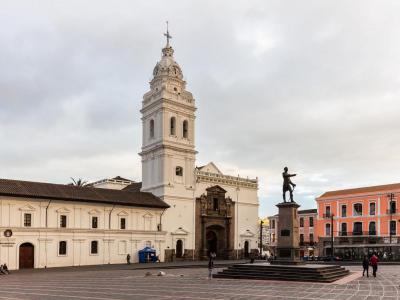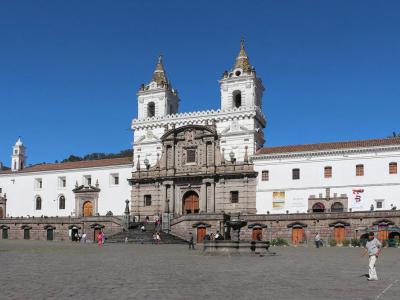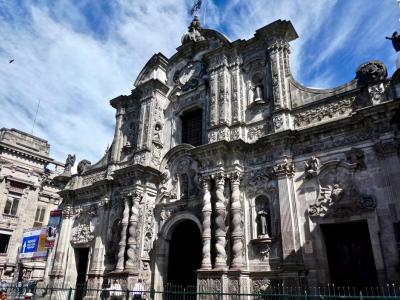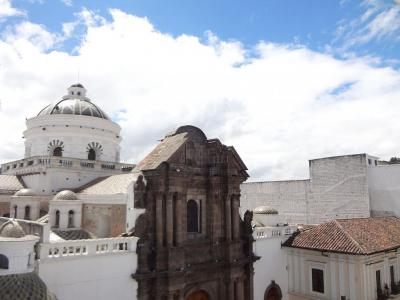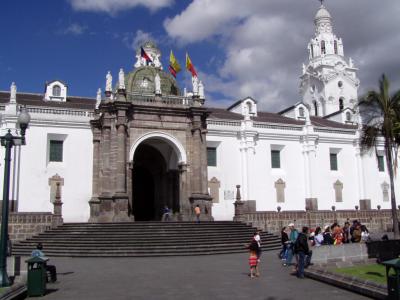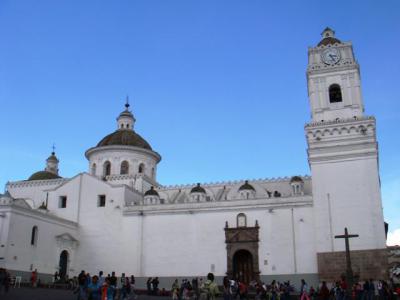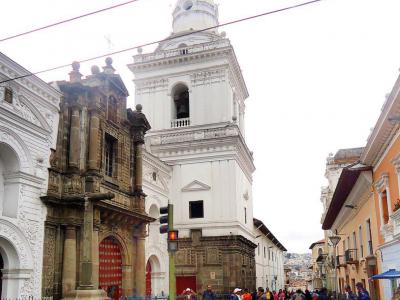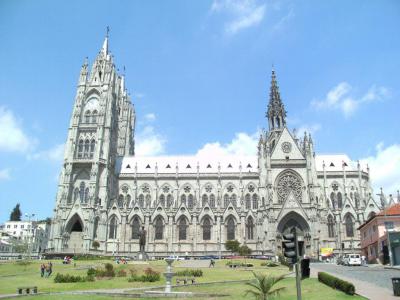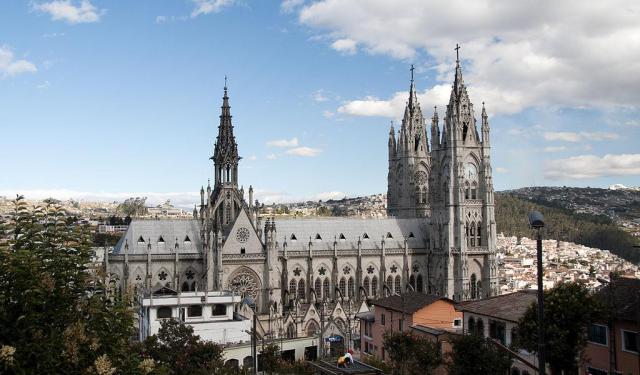
Historical Religious Buildings Tour (Self Guided), Quito
As a former Spanish colony, Ecuador and its capital city Quito are home to literally dozens of Catholic churches. The Spaniards brought their faith into the new country and built many great temples here, some of which even pre-date the city of Quito itself.
Among the key local landmarks of ecclesiastical architecture is the Santo Domingo Church, dating back to the 16th century and showcasing a stunning blend of Baroque and Moorish styles.
Another noteworthy site is the Church of San Francisco (Iglesia de San Francisco). This is one of the oldest and largest religious complexes in Quito, with a captivating mix of Gothic and Baroque influences, also known as the Mudéjar style.
La Compania, or the Church of the Society of Jesus, stands out for its ornate facade and intricate interiors adorned with golden leaf decorations. Its craftsmanship is a testament to the skill of the artisans of the time, similar to those who built the Church of the Sanctuary (Iglesia de El Sagrario), renowned for its beautiful altar.
The Quito Metropolitan Cathedral (Catedral Metropolitana de Quito) is a grand example of Ecuadorian colonial architecture. Its towering structure stands prominently on the city's skyline.
Meanwhile, the Convent of Mercy (Convento de la Merced), renowned for its impressive cloisters and religious artwork, reflects the devotion and dedication of the Mercedarian order.
The Church and Convent of San Agustin are significant for their historical and architectural value. Having witnessed centuries of Quito's history, they continue to be important spiritual centers.
Finally, the Basilica of the National Vow (Basilica del Voto Nacional) is a masterpiece of Neo-Gothic architecture, which, on top of that, offers panoramic views of the city.
If you plan to visit Quito, make sure to include these remarkable churches in your itinerary. Exploring their intricate details and learning about their historical significance can provide you with a deeper understanding of Ecuador's cultural heritage.
Among the key local landmarks of ecclesiastical architecture is the Santo Domingo Church, dating back to the 16th century and showcasing a stunning blend of Baroque and Moorish styles.
Another noteworthy site is the Church of San Francisco (Iglesia de San Francisco). This is one of the oldest and largest religious complexes in Quito, with a captivating mix of Gothic and Baroque influences, also known as the Mudéjar style.
La Compania, or the Church of the Society of Jesus, stands out for its ornate facade and intricate interiors adorned with golden leaf decorations. Its craftsmanship is a testament to the skill of the artisans of the time, similar to those who built the Church of the Sanctuary (Iglesia de El Sagrario), renowned for its beautiful altar.
The Quito Metropolitan Cathedral (Catedral Metropolitana de Quito) is a grand example of Ecuadorian colonial architecture. Its towering structure stands prominently on the city's skyline.
Meanwhile, the Convent of Mercy (Convento de la Merced), renowned for its impressive cloisters and religious artwork, reflects the devotion and dedication of the Mercedarian order.
The Church and Convent of San Agustin are significant for their historical and architectural value. Having witnessed centuries of Quito's history, they continue to be important spiritual centers.
Finally, the Basilica of the National Vow (Basilica del Voto Nacional) is a masterpiece of Neo-Gothic architecture, which, on top of that, offers panoramic views of the city.
If you plan to visit Quito, make sure to include these remarkable churches in your itinerary. Exploring their intricate details and learning about their historical significance can provide you with a deeper understanding of Ecuador's cultural heritage.
How it works: Download the app "GPSmyCity: Walks in 1K+ Cities" from Apple App Store or Google Play Store to your mobile phone or tablet. The app turns your mobile device into a personal tour guide and its built-in GPS navigation functions guide you from one tour stop to next. The app works offline, so no data plan is needed when traveling abroad.
Historical Religious Buildings Tour Map
Guide Name: Historical Religious Buildings Tour
Guide Location: Ecuador » Quito (See other walking tours in Quito)
Guide Type: Self-guided Walking Tour (Sightseeing)
# of Attractions: 8
Tour Duration: 2 Hour(s)
Travel Distance: 2.7 Km or 1.7 Miles
Author: vickyc
Sight(s) Featured in This Guide:
Guide Location: Ecuador » Quito (See other walking tours in Quito)
Guide Type: Self-guided Walking Tour (Sightseeing)
# of Attractions: 8
Tour Duration: 2 Hour(s)
Travel Distance: 2.7 Km or 1.7 Miles
Author: vickyc
Sight(s) Featured in This Guide:
- Santo Domingo Church and Square
- Iglesia de San Francisco (Church of San Francisco)
- La Compania (Church of the Society of Jesus)
- Iglesia de El Sagrario (Church of the Sanctuary)
- Catedral Metropolitana de Quito (Quito Cathedral)
- Convento de la Merced (Convent of Mercy)
- Church and Convent of San Agustin
- Basilica del Voto Nacional (Basilica of the National Vow)
1) Santo Domingo Church and Square
The Church of Santo Domingo is a must-visit attraction for those who appreciate religious architecture and history. Located in the historic center of Quito, the church and its accompanying convent and chapels occupy a large space facing the Plaza de Santo Domingo. The plaza is named after the church, which is one of the most important in Quito.
The church's interior is richly decorated, with cedar work covered in gold leaf and many paintings and carvings adorning the walls. The main altar is especially impressive, and there are ten side chapels that add to the splendor of the interior. The Chapel of the Virgen del Rosario is particularly noteworthy, but visitors should also take the time to explore the other chapels and appreciate the cultural significance of the temple.
The Cloister is another highlight of the complex, with its elegant corridors and bays adorned with double arches and octagonal pillars. It was designed by brother Antonio Rodríguez, based on the plans of Francisco Becerra.
The Chapel del Rosario is the richest and most famous of the church's chapels. It is located on the south side of the transept and is built on three different levels. From this chapel, visitors can see the Arch of Santo Domingo, which was built to overcome an unevenness in the land and features cone-shaped buttresses that resemble lookout posts.
The Plaza de Santo Domingo is a lovely open space in front of the church. At the center of the plaza, there is a monument to Marshal Antonio José de Sucre, a Venezuelan hero of the Independence. Around the plaza, visitors can also find important civil buildings, such as the old Colonial University of Santo Tomás de Aquino and the mansion of former president Gabriel García Moreno.
The plaza has undergone several transformations over the years, from a simple esplanade to a park and then a bus station. Today, it is paved with stone and offers visitors a quiet place to relax and take in the beautiful surroundings.
The church's interior is richly decorated, with cedar work covered in gold leaf and many paintings and carvings adorning the walls. The main altar is especially impressive, and there are ten side chapels that add to the splendor of the interior. The Chapel of the Virgen del Rosario is particularly noteworthy, but visitors should also take the time to explore the other chapels and appreciate the cultural significance of the temple.
The Cloister is another highlight of the complex, with its elegant corridors and bays adorned with double arches and octagonal pillars. It was designed by brother Antonio Rodríguez, based on the plans of Francisco Becerra.
The Chapel del Rosario is the richest and most famous of the church's chapels. It is located on the south side of the transept and is built on three different levels. From this chapel, visitors can see the Arch of Santo Domingo, which was built to overcome an unevenness in the land and features cone-shaped buttresses that resemble lookout posts.
The Plaza de Santo Domingo is a lovely open space in front of the church. At the center of the plaza, there is a monument to Marshal Antonio José de Sucre, a Venezuelan hero of the Independence. Around the plaza, visitors can also find important civil buildings, such as the old Colonial University of Santo Tomás de Aquino and the mansion of former president Gabriel García Moreno.
The plaza has undergone several transformations over the years, from a simple esplanade to a park and then a bus station. Today, it is paved with stone and offers visitors a quiet place to relax and take in the beautiful surroundings.
2) Iglesia de San Francisco (Church of San Francisco) (must see)
The dominant structure in San Francisco Square is the stunning Church of San Francisco, listed as a World Heritage Site in 1978. It is the oldest religious site in Ecuador.
The building has three churches, 13 cloisters for its monks, a library with historical documents, and more than 3,500 works of religious art in the convent’s museum. The complex was built between 1537 and 1560. A century later, it was finally completed, and today it is the largest Catholic complex in South America.
Earthquakes have repeatedly damaged parts of the church, which means the edifice is under constant maintenance. It has been included in the 2016 World Monuments Watch to ensure that religious art and architecture are conserved.
The interior expertly combines Catholic and Indigenous icons, while the exterior combines Renaissance and Baroque influences. The complex is an important religious and cultural center, receiving almost a million visitors every year.
The building has three churches, 13 cloisters for its monks, a library with historical documents, and more than 3,500 works of religious art in the convent’s museum. The complex was built between 1537 and 1560. A century later, it was finally completed, and today it is the largest Catholic complex in South America.
Earthquakes have repeatedly damaged parts of the church, which means the edifice is under constant maintenance. It has been included in the 2016 World Monuments Watch to ensure that religious art and architecture are conserved.
The interior expertly combines Catholic and Indigenous icons, while the exterior combines Renaissance and Baroque influences. The complex is an important religious and cultural center, receiving almost a million visitors every year.
3) La Compania (Church of the Society of Jesus) (must see)
The Church of the Society of Jesus is a Catholic clerical complex located in the historical center of the city of Quito. The religious edifice features gorgeous Spanish Baroque architecture.
Work on the church was started by Jesuit architects in 1605, and it was completed 160 years later. Although the Spanish priest Francisco Ayerd took charge of the construction, the mantel quickly changed hands. Eventually, the priest Venancio Gandolfi restarted work on the unfinished facade, which was completed in 1765.
Having been built over 160 years and with different architects, the church combines different architectural styles, although the Baroque style predominates.
The most impressive fact about the church is that seven tons of gold were used for the walls and ceilings. The central nave and the domes are decorated with gold as well. The façade of the main temple is entirely carved in volcanic stone.
Besides the beautiful architectural touches, there are 56 sculptures and 44 oil paintings. Some of the most famous paintings include Nicolas Javier de Goribar’s masterpieces “16 Prophets,” “The Four Evangelists,” and “The Cardinals of the Society of Jesus.”
There are also sculptures by Bernardo de Legarda. On each side of the main entrance, visitors can see paintings showing Hell and the Final Judgment. In addition, the guest will find representations of native flora and symbols of the ancestral peoples of Ecuador hidden in the church’s pillars, as well as an old organ dating back to 1889.
In recent years, Pope John Paul II held a mass at the church in 1985 during his visit to Ecuador, and Pope Francis visited the church in 2015.
Work on the church was started by Jesuit architects in 1605, and it was completed 160 years later. Although the Spanish priest Francisco Ayerd took charge of the construction, the mantel quickly changed hands. Eventually, the priest Venancio Gandolfi restarted work on the unfinished facade, which was completed in 1765.
Having been built over 160 years and with different architects, the church combines different architectural styles, although the Baroque style predominates.
The most impressive fact about the church is that seven tons of gold were used for the walls and ceilings. The central nave and the domes are decorated with gold as well. The façade of the main temple is entirely carved in volcanic stone.
Besides the beautiful architectural touches, there are 56 sculptures and 44 oil paintings. Some of the most famous paintings include Nicolas Javier de Goribar’s masterpieces “16 Prophets,” “The Four Evangelists,” and “The Cardinals of the Society of Jesus.”
There are also sculptures by Bernardo de Legarda. On each side of the main entrance, visitors can see paintings showing Hell and the Final Judgment. In addition, the guest will find representations of native flora and symbols of the ancestral peoples of Ecuador hidden in the church’s pillars, as well as an old organ dating back to 1889.
In recent years, Pope John Paul II held a mass at the church in 1985 during his visit to Ecuador, and Pope Francis visited the church in 2015.
4) Iglesia de El Sagrario (Church of the Sanctuary)
The Church of the Sanctuary (Iglesia de El Sagrario) in Quito is a magnificent Renaissance Catholic church, which is an integral part of the Metropolitan Cathedral complex. Although it is physically connected to the cathedral, the Church of the Sanctuary stands out as an independent church due to its size and importance in the city's art. This type of sacramental chapel was originally designed as a temple annexed to a larger one and was brought to the New World by the Spanish, who built cathedrals with similar chapels.
The Church of the Sanctuary was built on an arcade that closed the old Zanguña ravine, adjacent to the Cathedral. It was designed by the architect José Jaime Ortiz, who arrived in Quito from Alicante, Spain in 1694. The church was built according to the Italian Renaissance style that was popular at the time. The façade of the church was completed by Gabriel de Escorza in 1706, while the rest of the construction was finished in 1715.
The interior of the church is particularly impressive, with beautiful altarpieces and intricate wood carvings. The main gate is considered one of the most impressive manifestations of Quitoan Baroque. It was created by Bernardo de Legarda, a famous woodcarver, and features plant forms that culminate in capricious capitals and cornices. The central vault of the church is decorated with frescoes that depict scenes from the Bible, and was commissioned by master Legarda in 1742.
The Church of the Sanctuary was built on an arcade that closed the old Zanguña ravine, adjacent to the Cathedral. It was designed by the architect José Jaime Ortiz, who arrived in Quito from Alicante, Spain in 1694. The church was built according to the Italian Renaissance style that was popular at the time. The façade of the church was completed by Gabriel de Escorza in 1706, while the rest of the construction was finished in 1715.
The interior of the church is particularly impressive, with beautiful altarpieces and intricate wood carvings. The main gate is considered one of the most impressive manifestations of Quitoan Baroque. It was created by Bernardo de Legarda, a famous woodcarver, and features plant forms that culminate in capricious capitals and cornices. The central vault of the church is decorated with frescoes that depict scenes from the Bible, and was commissioned by master Legarda in 1742.
5) Catedral Metropolitana de Quito (Quito Cathedral)
The Quito Metropolitan Cathedral, known as Quito Cathedral, is located on the southwestern side of Independence Plaza. Construction on the church began in the mid-1550s. The architect in charge of the first two construction stages was the Spanish Antonio García. The Cathedral was officially completed and consecrated by the second Bishop of Quito, Pedro de la Peña, in 1572.
In 1660, the church was destroyed by the eruption of Mount Pichincha. Much of the damaged sections were rebuilt, and the entire church was completed in 1806. The church combines Baroque, Moorish, Neoclassic, and Gothic designs. The interior features artwork by Ecuadorian sculptor Manuel Chili, known as Caspicara.
From 1545 to 1848, the church served as the seat of the Diocese of Quito. In 1848, it became the Archdiocese of the city. And in 1995, it became the official Cathedral of Ecuador.
Quinto Cathedral is the final resting place of Field Marshal Antonio José de Sucre, Quito’s liberator, Cardinal de la Torre, an Ecuadorian cardinal of the Roman Catholic Church, as well as former Ecuadorian presidents and bishops.
In 1660, the church was destroyed by the eruption of Mount Pichincha. Much of the damaged sections were rebuilt, and the entire church was completed in 1806. The church combines Baroque, Moorish, Neoclassic, and Gothic designs. The interior features artwork by Ecuadorian sculptor Manuel Chili, known as Caspicara.
From 1545 to 1848, the church served as the seat of the Diocese of Quito. In 1848, it became the Archdiocese of the city. And in 1995, it became the official Cathedral of Ecuador.
Quinto Cathedral is the final resting place of Field Marshal Antonio José de Sucre, Quito’s liberator, Cardinal de la Torre, an Ecuadorian cardinal of the Roman Catholic Church, as well as former Ecuadorian presidents and bishops.
6) Convento de la Merced (Convent of Mercy)
The Basilica of Nuestra Señora de la Merced, also known as the Convento de la Merced, is a significant religious and historical landmark located in the heart of the Historic Center of Quito. The Basilica is the first church and headquarters of the Mercedarian Order in the country, and it holds the title of a Basilica. Its construction began in 1701 under the direction of the architect José Jaime Ortiz and was completed in 1737. The white building features five domes, a square tower, and is adorned with Inca and Arabic inscriptions.
One of the most remarkable features of the Basilica of Nuestra Señora de la Merced is its main altarpiece, which was built and carved by Bernardo de Legarda between 1748 and 1751. Visitors can also admire the sacristy, which is a stunning work from the early 19th century. Additionally, the church boasts several works of art by the artist Víctor Mideros, both inside the church and the sacristy.
The Basilica of Nuestra Señora de la Merced houses one of the most important historical libraries in Quito. The library is located on two floors of the north wing of the Convent, which is accessible through both the lower and upper floors. Bookcases line the walls of both levels, and the two floors are connected by a beautifully carved wooden spiral staircase. The library boasts a collection of 22,000 volumes and over 40,000 bibliographic records, making it an essential resource for scholars and researchers interested in Ecuadorian history and culture.
One of the most remarkable features of the Basilica of Nuestra Señora de la Merced is its main altarpiece, which was built and carved by Bernardo de Legarda between 1748 and 1751. Visitors can also admire the sacristy, which is a stunning work from the early 19th century. Additionally, the church boasts several works of art by the artist Víctor Mideros, both inside the church and the sacristy.
The Basilica of Nuestra Señora de la Merced houses one of the most important historical libraries in Quito. The library is located on two floors of the north wing of the Convent, which is accessible through both the lower and upper floors. Bookcases line the walls of both levels, and the two floors are connected by a beautifully carved wooden spiral staircase. The library boasts a collection of 22,000 volumes and over 40,000 bibliographic records, making it an essential resource for scholars and researchers interested in Ecuadorian history and culture.
7) Church and Convent of San Agustin
The Church and Convent of San Agustín is a must-see for anyone visiting Quito. It is one of the seven monumental churches of the 16th and 17th centuries and is rich in history and architectural beauty.
The Augustinian order was assigned the site where the church and convent now stand in 1573. They began construction of the convent, but the church was not built until much later, between 1606 and 1617, by Juan del Corral, based on the plans designed by the architect Francisco Becerra in 1581. Becerra also worked on the design of the Church of Santo Domingo.
The church's main portal is a beautiful example of the Neoclassical style printed by Diego de Escarza, which features Spanish and Amerindian decorative elements. The bell tower is also impressive, reaching a height of 37 meters and containing the same bells placed there in the 17th century.
The convent, built in the 16th century, has a separate entrance on the eastern side of the façade and forms a single architectural complex together with the temple and a small atrium with a stone cross on the corner diametrically opposite the latter's entrance. The cloister was completed in the middle of the 17th century and features gardens and a large session hall called the Chapter House, which was only conceived in the 18th century. It was here that the Act of the Governing Board of 1809 was signed and the first cry of freedom was given.
One of the main attractions of the Church of San Agustín is the enormous painting that hangs on its main altar. The painting, titled "The Triumph of Saint Augustine," is the work of Miguel de Santiago and was completed in the 17th century.
The Augustinian order was assigned the site where the church and convent now stand in 1573. They began construction of the convent, but the church was not built until much later, between 1606 and 1617, by Juan del Corral, based on the plans designed by the architect Francisco Becerra in 1581. Becerra also worked on the design of the Church of Santo Domingo.
The church's main portal is a beautiful example of the Neoclassical style printed by Diego de Escarza, which features Spanish and Amerindian decorative elements. The bell tower is also impressive, reaching a height of 37 meters and containing the same bells placed there in the 17th century.
The convent, built in the 16th century, has a separate entrance on the eastern side of the façade and forms a single architectural complex together with the temple and a small atrium with a stone cross on the corner diametrically opposite the latter's entrance. The cloister was completed in the middle of the 17th century and features gardens and a large session hall called the Chapter House, which was only conceived in the 18th century. It was here that the Act of the Governing Board of 1809 was signed and the first cry of freedom was given.
One of the main attractions of the Church of San Agustín is the enormous painting that hangs on its main altar. The painting, titled "The Triumph of Saint Augustine," is the work of Miguel de Santiago and was completed in the 17th century.
8) Basilica del Voto Nacional (Basilica of the National Vow) (must see)
At its altitude of 9,350 feet, Quito is the second-highest city in the world (trailing only La Paz, Bolivia). But even at this height, the visitors will be tempted to climb to the top of the Basilica of the National Vow to see the stunning views!
The idea of Quito’s most impressive Roman Catholic church came about in 1883. A congressman, Father Julio Matovelle, suggested building a monument as a reminder of the consecration of Ecuador to the Sacred Heart of Jesus, its patron, and protector. A year later, the construction began to take shape, and the first stone was placed in 1892.
It took 30 years to build the Basilica, but it has not officially been completed. Local legend states that the world will end when completion is final. Located in the San Juan neighborhood, the Basilica has a height of 377 meters, which makes it South America’s highest church.
Designed in the Neo-Gothic style, the Basilica’s construction was supervised by Emilio Tarlier, a French architect. Tarlier fused the design of France’s Notre Dame and Spain’s Cathedral of Burgos. For the construction, Congress designated 12,000 pesos.
Around the church’s central nave are 24 chapels. Each chapel represents a province of Ecuador. There is also an underground crypt and a pantheon, where four Heads of State have been laid to rest.
Visiting the Basilica is easy, as the guests can walk around and see the architecture on a self-guided tour. They can climb even higher than Quito’s 9,350 feet, take an elevator (or climb the stairs) to the top floor, where there are a museum and a café. However, what’s spectacular are the views of the city from the top of the tower.
The Basilica of the National Vow is open daily from 9 am to 4 pm and the towers from 8:30 am to 6 pm.
The idea of Quito’s most impressive Roman Catholic church came about in 1883. A congressman, Father Julio Matovelle, suggested building a monument as a reminder of the consecration of Ecuador to the Sacred Heart of Jesus, its patron, and protector. A year later, the construction began to take shape, and the first stone was placed in 1892.
It took 30 years to build the Basilica, but it has not officially been completed. Local legend states that the world will end when completion is final. Located in the San Juan neighborhood, the Basilica has a height of 377 meters, which makes it South America’s highest church.
Designed in the Neo-Gothic style, the Basilica’s construction was supervised by Emilio Tarlier, a French architect. Tarlier fused the design of France’s Notre Dame and Spain’s Cathedral of Burgos. For the construction, Congress designated 12,000 pesos.
Around the church’s central nave are 24 chapels. Each chapel represents a province of Ecuador. There is also an underground crypt and a pantheon, where four Heads of State have been laid to rest.
Visiting the Basilica is easy, as the guests can walk around and see the architecture on a self-guided tour. They can climb even higher than Quito’s 9,350 feet, take an elevator (or climb the stairs) to the top floor, where there are a museum and a café. However, what’s spectacular are the views of the city from the top of the tower.
The Basilica of the National Vow is open daily from 9 am to 4 pm and the towers from 8:30 am to 6 pm.
Walking Tours in Quito, Ecuador
Create Your Own Walk in Quito
Creating your own self-guided walk in Quito is easy and fun. Choose the city attractions that you want to see and a walk route map will be created just for you. You can even set your hotel as the start point of the walk.
Quito Introduction Walking Tour
Nestled high in the Andean foothills, at an altitude of 2,850m, Ecuador's capital Quito is deservedly nicknamed "The City in the Clouds". Its full formal title, however, is much longer: "The Very Noble and Loyal City of San Francisco of Quito". The name Quito is derived from the Quitu tribe that originally inhabited the area, and is a combination of two words: quitso... view more
Tour Duration: 2 Hour(s)
Travel Distance: 2.4 Km or 1.5 Miles
Tour Duration: 2 Hour(s)
Travel Distance: 2.4 Km or 1.5 Miles
The Most Popular Cities
/ view all
